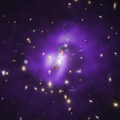File:Phoenix Cluster (2019-44-4584).tif

Original file (1,306 × 1,306 pixels, file size: 2.41 MB, MIME type: image/tiff)
Captions
Captions
Summary
[edit]| DescriptionPhoenix Cluster (2019-44-4584).tif |
English: The Phoenix galaxy cluster contains the first confirmed supermassive black hole that is unable to prevent large numbers of stars from forming in the core of the galaxy cluster where it resides.
The Phoenix Cluster system has several distinct elements that help tell the story of its unusually high star formation. Data from NASA's Chandra X-ray Observatory show that the coolest gas it can detect is located near the center of the cluster. In the absence of significant sources of heat, astronomers expect cooling to occur at the highest rates in a cluster’s center, where the densest gas is located. Optical observations with the Hubble Space Telescope provide evidence for further cooling of gas near the center of the Phoenix Cluster. Ten billion solar masses of cooler gas are located along filaments to the north and south of the black hole, which likely originate from outbursts by the supermassive black hole located in the center of the image. The outbursts generated jets seen in radio waves by the Very Large Array (VLA) radio telescope. As the jets push outward, they inflated cavities, or bubbles, in the hot gas that pervades the cluster. Chandra’s sharp X-ray vision detected these cavities. This image was made by combining data from Chandra, Hubble and the VLA. X-rays from Chandra depict hot gas in purple and radio emission from the VLA features jets in red. Optical light data from Hubble show galaxies (in yellow), and filaments of cooler gas where stars are forming (in light blue). |
| Date | 18 November 2019 (upload date) |
| Source | Phoenix Cluster |
| Author | NASA, ESA, and NRAO |
| Other versions |
|
Licensing
[edit]| Public domainPublic domainfalsefalse |
| This file is in the public domain because it was created by NASA and ESA. NASA Hubble material (and ESA Hubble material prior to 2009) is copyright-free and may be freely used as in the public domain without fee, on the condition that only NASA, STScI, and/or ESA is credited as the source of the material. This license does not apply if ESA material created after 2008 or source material from other organizations is in use. The material was created for NASA by Space Telescope Science Institute under Contract NAS5-26555, or for ESA by the Hubble European Space Agency Information Centre. Copyright statement at hubblesite.org or 2008 copyright statement at spacetelescope.org. For material created by the European Space Agency on the spacetelescope.org site since 2009, use the {{ESA-Hubble}} tag. |
File history
Click on a date/time to view the file as it appeared at that time.
| Date/Time | Thumbnail | Dimensions | User | Comment | |
|---|---|---|---|---|---|
| current | 11:28, 25 August 2023 |  | 1,306 × 1,306 (2.41 MB) | OptimusPrimeBot (talk | contribs) | #Spacemedia - Upload of https://stsci-opo.org/STScI-01EVSV4PBE3R2BPBZETJ3GKSXM.tif via Commons:Spacemedia |
You cannot overwrite this file.
File usage on Commons
There are no pages that use this file.
Metadata
This file contains additional information such as Exif metadata which may have been added by the digital camera, scanner, or software program used to create or digitize it. If the file has been modified from its original state, some details such as the timestamp may not fully reflect those of the original file. The timestamp is only as accurate as the clock in the camera, and it may be completely wrong.
| Author | Space Telescope Science Institute Office of Public Outreach |
|---|---|
| Width | 1,306 px |
| Height | 1,306 px |
| Bits per component |
|
| Compression scheme | LZW |
| Pixel composition | RGB |
| Orientation | Normal |
| Number of components | 3 |
| Number of rows per strip | 66 |
| Horizontal resolution | 72 dpi |
| Vertical resolution | 72 dpi |
| Data arrangement | chunky format |
| Software used | Adobe Photoshop CC 2019 (Macintosh) |
| File change date and time | 14:17, 5 November 2019 |
| Exif version | 2.21 |
| Color space | Uncalibrated |

